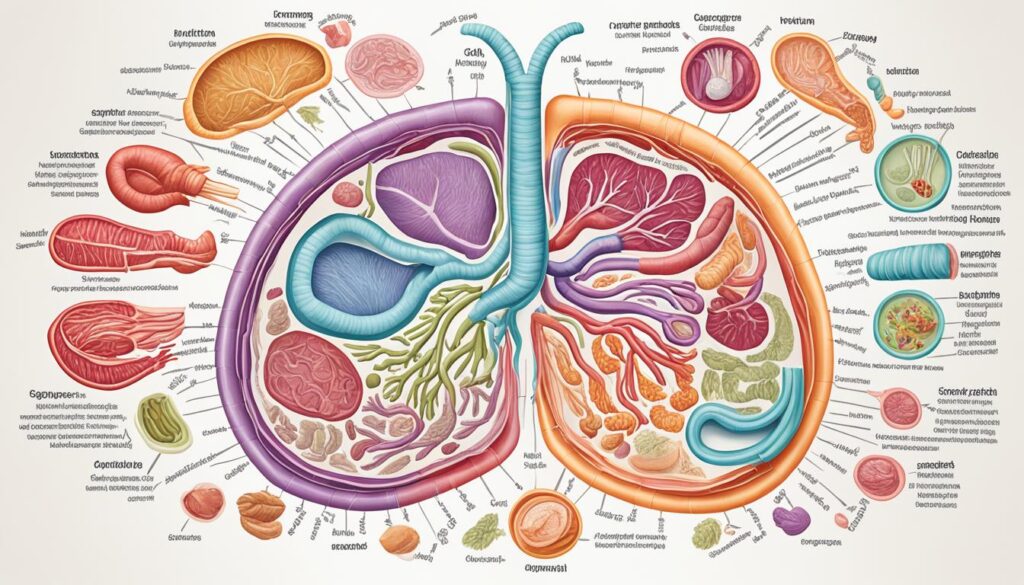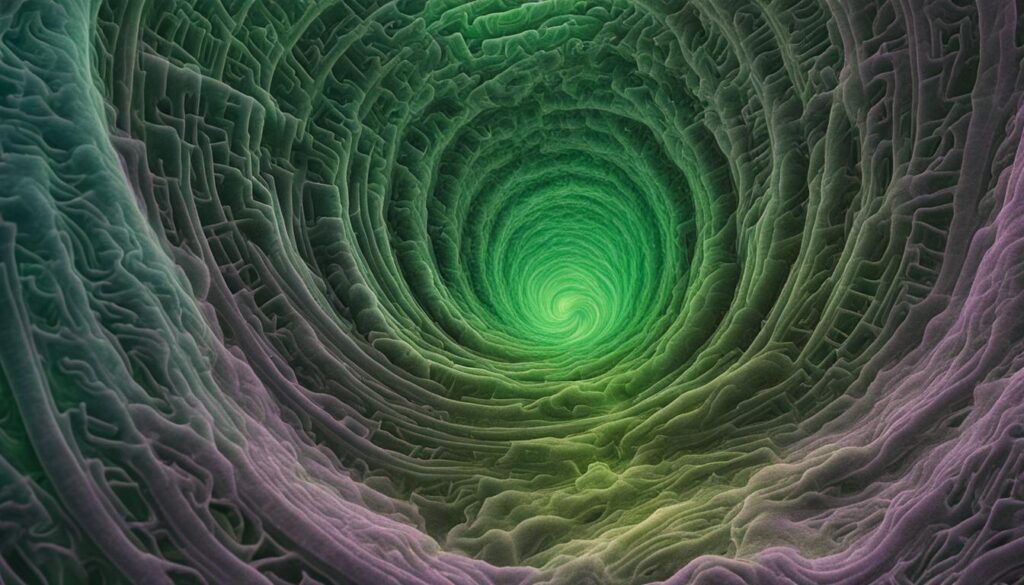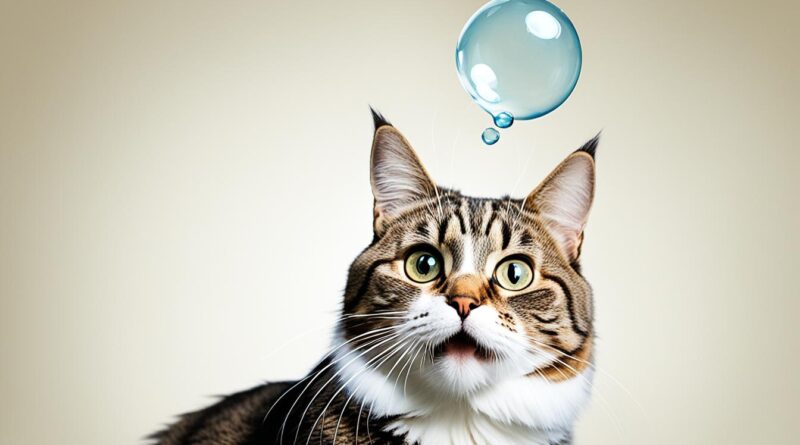Can Cats Burp? Feline Digestive Curiosities Unveiled.
Cats are fascinating creatures, and their digestive systems have some curiosities of their own. One question that often arises is whether cats can burp. Let’s explore this topic and uncover the truth about feline burping.
When it comes to burping, cats have their own unique way of dealing with trapped air in their stomachs. Unlike humans, they don’t typically burp to release the air. Instead, cats rely on other processes within their digestive system to expel the gas.
The anatomy of a cat’s digestive system plays a significant role in this feline curio. Cats have a relatively simple digestive tract compared to humans, with a stomach structure and esophagus designed to efficiently process their food. Their intestines then absorb the necessary nutrients.
So, why don’t cats burp like humans do? It’s all about their unique biology. Cats have an esophageal sphincter, a muscular valve that connects the esophagus to the stomach. This valve remains tightly closed, making it difficult for air to escape upwards, resulting in a lack of burping.
While cats may not burp, they still have a gas release mechanism. Cats release trapped air through flatulence, which is a normal part of their digestive process. This helps them relieve any discomfort caused by gas buildup.
To summarize, cats don’t typically burp, and their unique biology and digestive system are the reasons behind it. Understanding these feline digestive curiosities allows us to appreciate the remarkable adaptations that cats have developed over time.
Key Takeaways:
- Cats don’t have the ability to burp like humans do.
- Cats release trapped air through flatulence instead.
- Their unique anatomy, particularly the esophageal sphincter, prevents burping.
- Flatulence is a normal part of a cat’s digestive process.
- Cats use other mechanisms to expel gas and relieve discomfort.
The Anatomy of a Cat’s Digestive System
To understand if cats can burp, we need to first examine their digestive system. Cats have a relatively simple digestive tract compared to humans. Their digestive system is specifically adapted to meet their dietary needs as obligate carnivores. Let’s take a closer look at the key components of a cat’s digestive system.
Stomach Structure
A cat’s stomach is a muscular organ that plays a crucial role in breaking down food. It has a highly acidic environment, which aids in the digestion of proteins. The stomach’s muscular walls contract and churn the food to further break it down into smaller particles.

Esophagus
The esophagus is a tube-like structure that connects the mouth to the stomach. It transports food from the mouth to the stomach through a process called peristalsis, which involves rhythmic muscle contractions. The esophagus utilizes this mechanism to push the food towards the stomach.
Intestines
After the food leaves the stomach, it enters the small intestine. This is where the majority of nutrient absorption takes place. The small intestine is long and highly coiled, maximizing the surface area for nutrient absorption. It is lined with tiny finger-like projections called villi, which further increase the surface area for nutrient absorption.
Once the nutrients are absorbed, the remaining waste material passes into the large intestine or colon. The colon’s main function is to reabsorb water and electrolytes from the waste material, resulting in the formation of feces, which is eventually eliminated through the rectum and anus.
Overall, the cat’s digestive system is designed to efficiently process and extract nutrients from their carnivorous diet. Understanding the intricacies of their digestive system helps us appreciate the unique biology of our feline friends.
The Burping Phenomenon in Cats
While cats do experience the buildup of gas in their stomachs, they have a different way of dealing with it compared to humans. Unlike people, cats don’t typically burp to release the trapped air. Instead, they rely on other processes within their digestive system to expel the gas.
Gas in a cat’s stomach can cause discomfort and bloating. However, cats have evolved a unique feline burping process that allows them to release trapped air. Rather than expelling the gas through burping, cats expel air from their stomachs through other means.
One way cats release trapped air is through the feline digestive process itself. As food travels through a cat’s digestive system, it undergoes fermentation, producing gases. These gases can build up in the stomach, causing discomfort. To relieve this pressure, cats have a natural mechanism that allows them to release the trapped air.
Another method cats use to release gas is through flatulence, also known as passing gas. Although it may not be a topic of conversation among cat owners, cats do pass gas as part of their normal digestion. It’s their way of expelling the excess gas that has accumulated in their stomachs.
So, while cats may not burp like humans, they do have mechanisms in place to release gas and alleviate any discomfort caused by gas buildup.

Through their unique feline burping process, cats can release gas and maintain a healthy digestive system. This natural gas expulsion mechanism ensures their comfort and well-being.
How Cats Release Trapped Air
Cats, like humans, experience the discomfort of trapped air or gas in their digestive system. However, their method of releasing this gas is quite different. Instead of burping, cats rely on flatulence, also known as passing gas, to alleviate the built-up pressure.
While not as frequent or audible as human farts, a cat’s flatulence is a normal part of their digestion process. It allows them to release the gas that has accumulated in their stomach, providing relief from any discomfort.
But how exactly do cats release gas?
Cats release gas through their rectum. The gas, produced during the digestion process, travels through the intestines and eventually reaches the rectum. From there, it is expelled through the anus, usually in the form of a silent release.
This natural mechanism of gas release in cats is essential for maintaining a healthy digestive system. It prevents excessive gas buildup and ensures the smooth passage of food through their digestive tract.
Factors Affecting Cat’s Flatulence
Several factors can influence the frequency and intensity of a cat’s flatulence:
- Diet: Certain foods, such as those high in fiber or poorly digestible carbohydrates, can contribute to increased gas production in cats.
- Eating Habits: Cats who eat too quickly or consume large amounts of food in one sitting may swallow excess air, leading to increased flatulence.
- Underlying Health Issues: Some medical conditions, such as gastrointestinal disorders or food sensitivities, can cause excessive gas production in cats.
As a responsible cat owner, it’s important to monitor your cat’s digestive health and make any necessary adjustments to their diet or lifestyle to minimize flatulence and promote overall well-being.
Managing Cat’s Flatulence
If you notice that your cat is experiencing excessive flatulence or discomfort, here are a few steps you can take:
- Dietary Modifications: Consult with your veterinarian to determine if a change in diet is necessary. Switching to a cat food that is easily digestible and free from potential irritants may help reduce flatulence.
- Feeding Practices: Divide your cat’s meals into smaller portions and feed them more frequently throughout the day. This can prevent overeating and reduce the amount of air swallowed during meals.
- Regular Vet Check-ups: Schedule regular check-ups with your veterinarian to identify any underlying health conditions that may contribute to excessive flatulence.
By implementing these measures, you can help manage your cat’s flatulence and ensure their digestive system remains healthy and comfortable.
Why Cats Don’t Burp
Cats have a fascinating anatomy and biology that contribute to their unique digestive system, explaining why they don’t burp like humans do. One of the key factors is the cat’s esophageal sphincter, a muscular valve connecting the esophagus to the stomach. This sphincter is designed to prevent the backflow of stomach contents, keeping it tightly closed.
Unlike humans, cats have a strong esophageal sphincter that doesn’t allow air to escape upwards easily. As a result, burping becomes challenging for cats, and they have alternative mechanisms to release trapped air from their stomach.
Cats rely on their feline biology to handle gas buildup effectively. Instead of burping, cats release trapped air through flatulence, which is a normal part of their digestive process. This gas release mechanism helps alleviate any discomfort caused by the accumulation of gases in their stomachs.
Interesting Fact
While cats don’t burp, they are exceptional at grooming themselves. Their instinctual grooming behavior helps prevent excessive air ingestion, reducing the likelihood of excessive gas buildup in their digestive system.
Understanding the unique biology and anatomy of cats sheds light on why they have different mechanisms for releasing trapped air. These adaptations in a cat’s digestive system enable them to maintain balance and comfort without the need for burping.
So, the next time you observe your cat releasing trapped air through flatulence, remember that it’s a natural and necessary part of their digestion. Embrace the marvels of feline biology and appreciate the quirks that make cats such intriguing companions.
Conclusion
In conclusion, cats have a unique biology and digestive system that sets them apart from humans when it comes to burping. Unlike us, cats do not typically burp to release trapped air. Instead, they have a remarkable adaptation that allows them to release the gas through flatulence. While this may sound amusing, it’s actually a normal part of their digestive process and helps to alleviate any discomfort caused by gas buildup.
Understanding the feline digestive system and their gas release mechanism gives us a fascinating glimpse into the intricate biology of cats. From their stomach structure to the esophageal sphincter, every aspect of their anatomy is designed to ensure proper digestion without the need for burping. This unique biology is just one of the many factors that make cats such intriguing and mysterious creatures.
So, the next time you wonder if your cat can burp, remember that while they may not burp like humans, their gas release mechanism through flatulence serves the same purpose. Embrace these quirks of feline biology and continue to marvel at the wonders of our furry companions. Cats truly are fascinating creatures with a digestive system all their own.
FAQ
Can cats burp?
No, cats do not typically burp like humans do. Their unique biology and digestive system have adaptations that allow them to release trapped air through flatulence instead.
How do cats release trapped air?
Cats release trapped air or gas through flatulence, also known as passing gas. This is a normal part of their digestive process and helps to relieve any discomfort caused by gas buildup.
Do cats have the ability to burp?
While cats have the physical ability to burp, they do not typically do so. Their esophageal sphincter, a muscular valve that connects the esophagus to the stomach, remains tightly closed, making it difficult for air to escape upwards.
Why don’t cats burp like humans?
Cats have a different digestive system than humans, and their esophageal sphincter is designed to prevent backflow of stomach contents. This results in a lack of burping and a reliance on other processes, such as flatulence, to release trapped air.
Can cats belch?
No, cats do not typically belch. Their digestive system does not work in the same way as humans, and the anatomy of their esophageal sphincter prevents the release of air through belching.
Can cats expel air from their stomachs through belching?
Cats cannot expel air from their stomachs through belching due to the design and functionality of their digestive system. They release trapped air through flatulence instead.


